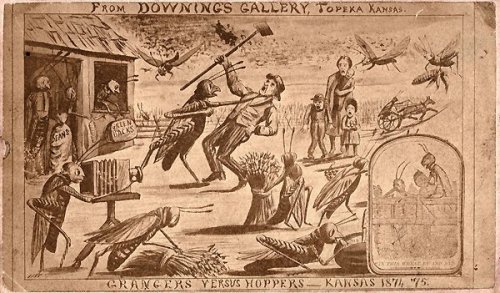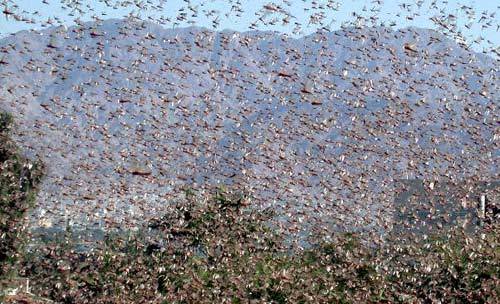peashooter85:The Great Locust Swarms of 1874 - 1875.“The locusts have no king, Yet all of them go ou
peashooter85:The Great Locust Swarms of 1874 - 1875.“The locusts have no king, Yet all of them go out in ranks.”—Proverbs 30:27In 1874 and 1875, the skies of the Midwest and Great Plains darkened for days. Seen at the horizon miles away, at first people believed that some much needed rain was on the way. However, as the cloud approached, to their horror it was realized that the cloud was a massive swarm of billions of locusts. Over the next year multiple swarms would infest the Great Plains in Biblical proportions. The swarms of Rocky Mountain Locusts (Melanoplus spretus) were driven from the foothills of the Rocky Mountains due to drought and migrated through Kansas, Oklahoma, Texas, Missouri, Nebraska, Wyoming, the Dakotas, Iowa, and Minnesota. A resident of Edwards County, Kansas remarked,“I never saw such a sight before. This morning, as we looked up toward the sun, we could see millions in the air, a moving grey green screen that blotted out the sky. They looked like snowflakes.” The locusts caused $200 million in crop damage, consumed everything that was green, and were noted to even sheer the wool off sheep and the paint off wood. Midwesterners tried to shut themselves in their houses, but the swarms were so massive that they got in through nooks and crannies regardless. Nothing could stop them. At night people had to shake their sheets clear of the insects, then wake up to find themselves covered with them in the morning. A Kansas woman named Adelheit Viets claimed, “I was wearing a dress of white with a green stripe. The grasshoppers settled on me and ate up every bit of the green stripe in that dress before anything could be done about it.“ Many poor farming families, stripped of their livelihood and provisions returned east seeking factory work in the cities, forming a massive exodus at a time when most people were headed west. Many other poor souls died. In that year the population of Kansas decreased by 1/3rd. Some families were so desperate that they had to resort to eating the locusts to avoid starvation. Territorial governments issued bonds to raise money for disaster relief while the Federal Government likewise devoted $30,000. Across the country citizens donated food, clothing, and other necessary supplies, while the US Army delivered 2 million tons of rations by wagon and train.In June of 1875 one particularly large swarm traveled through Kansas, Nebraska, then up north towards Minnesota. One witness who recorded the event in detail was a physician and meteorologist named Dr. Albert Childs from Cedar Creek. Dr. Childs used a telescope to estimate that the swarm covered a front 110 miles wide. He determined that the swarm was traveling at 15 miles per hour and it took five whole days to pass through the town. Thus he was able to determine that the swarm was 1,800 miles long. In total the insect horde covered an area roughly 198,000 square miles, the size of Pennsylvania, Connecticut, Delaware, Maryland, Maine, Massachusetts, New York, New Hampshire, Vermont, and Rhode Island combined. Dr. Childs then sent messages along several telegraph lines to confirm the accuracy of his measurements. The swarm is estimated to have infested a total area of 2 million square miles by the end of its travels. In his book Paradise Found, entomologist Steven Nicholls calls the incident “The Perfect Swarm”. -- source link


